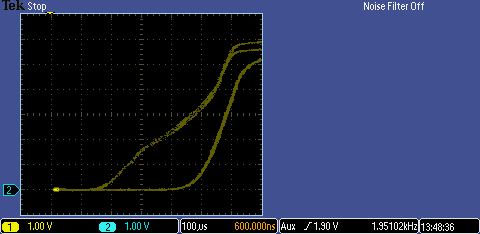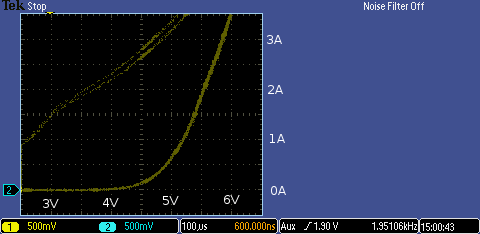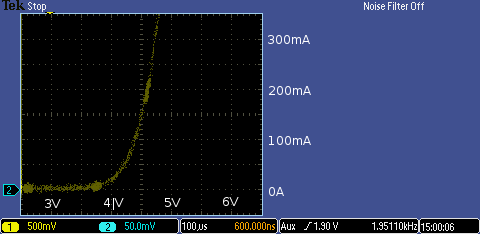This is a short follow-up to Experimenting with MOSFETS: Total Gate Charge where I looked at 'total gate charge' for an IRF730, an n-channel power MOSFET.
Since I still had the test board wired up, I thought it might be interesting to see if could get a quick plot of the transfer characteristic - the way that the drain current varies with gate voltage.
I've taken the previous circuit, bypassed the constant current generator in the drain and then plotted the drain current against gate voltage using the XY facility of the oscilloscope (which, unfortunately, is a bit on the basic side). This isn't going to be very precise, but it does seem to work and give me a fairly sensible looking plot.
Horizontal scale (Vgs) is one volt per division. Vertical scale (drain current) is one volt per amp. I've done this with a drain voltage of 10V, so the results may differ a little from the datasheet which was plotted at 50V Vds.
The trace we're interested in is the one that goes horizontally to about 4V and then lifts off smoothly with increasing current. I wouldn't take too much notice of what happens above 4 amps, or so.
The other curve is when the Arduino control pulse ends, the MOSFET part turns off and the current returns back to land, awkwardly, at zero; it's somewhat messy because the gate is being discharged through a resistor.
Here's the plot from the datasheet. Their curve looks quite a different shape to mine but it isn't really, it's just that it is plotted with a log scale for the current rather than my linear one. My currents are a little lower, but then my 'typical' part is probably different to their 'typical' part. Here are the plots again, this time with a 3V offset on the horizontal Vgs scale and two different scales for the vertical drain current. I've annotated them both with values against the scales - it's too complicated trying to keep explaining in words (I probably need a better oscilloscope that can do that kind of thing for me).
The second one is starting to show the noise from the current probe quite badly. I'm obviously not going to be able to easily find the threshold voltage this way - it's down there, somewhere, but the curve is so shallow below 3.5V that it's anybody's guess where it is in the noise. Guess that will have to be another experiment entirely.
If you found this interesting and would like to see more blogs I've written, a list can be found here: jc2048 Blog Index |





Top Comments
-

jw0752
-
Cancel
-
Vote Up
+1
Vote Down
-
-
Sign in to reply
-
More
-
Cancel
Comment-

jw0752
-
Cancel
-
Vote Up
+1
Vote Down
-
-
Sign in to reply
-
More
-
Cancel
Children